Conservation of fragile paint.
During the restoration and conservation of the thirteen La Farge windows at Salve Regina University, we were faced with the challenge to conserve and bring back the missing detail on the left side of St. John The Evangelist’s face. After much investigation in our studio and Professor Richard Newman at the MFA in Boston, we determined that the best solution in this particular case would be to introduce and fill in with artists oil paints, the areas of missing detail on St. John’s face. Matthew Fallon, a talented artist and painter from our studio, sketched on paper a full size head of St. John and what he should look like, or probably looked like originally. Once the sketch was approved by the committee from Salve Regina University, Matthew made several colored sketches on clear Mylar using first colored pencils and later artists oil base paints, in order to get an accurate, color selection. Matthew then began filling in and painting directly onto the glass, being extremely careful to only paint within the deteriorated areas. The results were very encouraging, and aesthetically pleasing. We were very careful not to “over do it” as we wanted the final product to look as original as possible. This process is still reversible, in that in the event the new paint must be removed, it can be easily cleaned off with acetone, and the original stable paint on the right side of St. John, would not be affected at all.









St. John’s face before conservation
Full scale pencil sketch
Color pencil sketch 2
Color pencil sketch 1
Color pencil sketch 3
Oil base paint sketch 1
Oil base paint sketch 2
St. John after conservation
St. John’s face after conservation
During a project, we always try to involve the client, tell them what options are available to them and what is best for their windows, as there is much to consider during a stained glass conservation project. This is especially true when dealing with fragile painted glass that usually depicts and important element in a window. It is difficut to pin point the cause as to why stained glass paint fails, as there are many factors that contribute to this unfortunate issue. Not every incident is the same and therefore there is not a "standard" solution for all fragile painted glass. With close inspection and analysis of the glass and paint, we can determine the best conservation method and approach for the painted piece to ensure that any original art work is not compromised, and that whatever conservation technique we decide to pursue is reversible.
Here is our philosophy on the subject:
Unless the painted elements are completely missing, repainting should be avoided. If the repainting approach is chosen, the single most important factor is to replicate the original artist's hand, technique and intent. It has always been our view that the purpose of restoration is not to make a window “as good as new” but to make it “as good as old”. Determining a philosophical direction for the project is critical to its ultimate success or failure. It is not our place to make the final decision, however, it is my responsibility to do our best in trying to educate the client in all the available techniques and approaches, and give them my recommendations. Then, together we can arrive at a sound decision.
There are three options available in regards to fragile and unstable paint:
a. One is the application of a cover plate to the affected piece (see photos below from a window we conserved at the Christian Science Church in Boston). The missing artwork is painted on a very thin clear piece of clear glass that is cut to the same shape of the original piece. The paint is applied to the glass surface closest to the original glass, (underside) and fired in a kiln for permanency. The plate is then mechanically attached with lead to the original piece exhibiting the paint loss. This technique is totally reversible as the original piece is never altered. This technique, however, has one small negative final effect: Once attached to the original piece, the cover plate could have a mirror-like effect as it reflects light. Unfortunately, there is no way around this. Depending on the lighting that will be present in the room where the windows will be installed and exhibited this minor issue may or may not be a factor.
b. The second option is to reintroduce the missing detail only, over the original glass, using an oil base paint (see phots below from St. John's window, one of the 13 La Farge windows we restored at Salve Regina University in Newport, RI). This technique gives great flexibility, especially when restoring painted pieces from a La Farge window, as he very often used oil paint to decorate his windows, especially the flesh pieces. Before introducing new paint in the missing areas, the piece/s are coated with a paint consolidant. This will stabilize any loose original paint fragments and also create a protective “barrier” between the original paint and the newly introduced paint, ensuring that the original paint is never disturbed. After the missing details have been reintroduced and it is satisfactory to all, the entire piece is then consolidated. The process is achieved through the introduction of a chemical adhesive between the fragile paint and the glass surface. For the last fifteen years, we have been using an acrylic polymer of 3% solution of Paraloid B-72 in acetone, with great results and success.
c. The third option is to just clean the painted glass as best as possible without disturbing the original paint and do nothing to bring back the missing details, but to just consolidate the paint during restoration of the window, so that the paint does not continue to deteriorate.
A stained glass window is artwork and unfortunately over time it deteriorates just like any other art form. It is our responsibility as conservators to maintain them, their beauty and their materials.
Below are samples of conservation of fragile paint from projects we have completed. Hope they are helpful.
Roberto
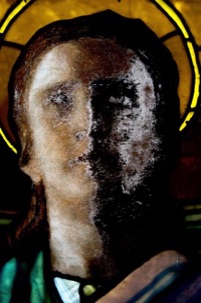
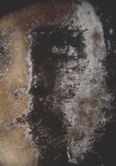
Below is a series of photographs showing the application of a reverse-painted cover plate as described above in option “a”. This was executed during restoration of an opalescent window located at the First Church of Christ, Scientist The Mother Church in Boston.
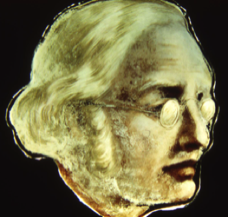
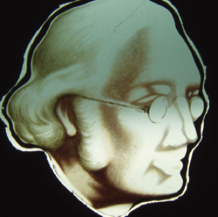
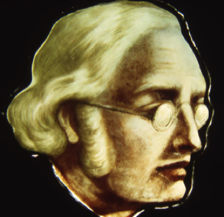
Painted head exhibiting paint loss, before conservation.
Painted cover plate. The cover plate is painted on the underside
eliminating parallax.
After conservation and application of the painted cover plate. The original painted piece was never disturbed. This technique is totally reversible.
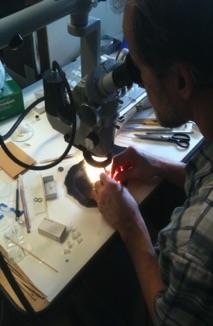
Professor Richard Newman at the MFA
analyzing paint condition
St. John’s face before conservation

21 Highland Circle - Needham, Massachusetts 02494